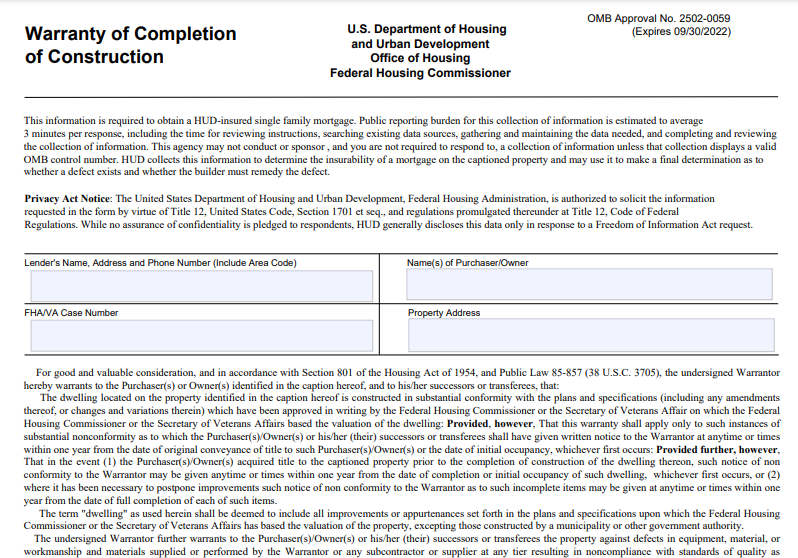Table of Contents
VA Form 26-1859 Printable, Fillable in PDF – When a builder wants to sell a new home, he or she must sign Form HUD-92544, Warranty of Completion of Construction, which certifies that the building was constructed by the plans and specifications approved by the Federal Housing Administration. Additionally, this statement will be used to repair workmanship defects at the expense of the builder during the period for which the warranty is valid. The warranty period begins on the date on which the purchaser obtains title to the property or moves into the property. In the case of all properties that will receive high loan-to-value financing, this document serves as an insurance policy to ensure that the builder complies with the construction standards and to provide peace of mind for those who will be living in the property in the future. Repairs must be completed within a reasonable period if the builder is found to be at fault for structural defects in the structure of the building.
Instructions For The HUD Warranty Of Completion
The HUD-92544 form addresses three major points:
- A construction flaw caused by defective materials or faulty workmanship will be corrected at no cost to the homeowner during the first year of the warranty period, according to the builder.
- During the second year of the warranty period, the builder provides an additional warranty for the components of the house, such as piping, heating, plumbing, and other similar items.
- The builder is liable for structural problems that cause the building to be less livable for ten years after the building is completed.
To complete a HUD Warranty of Completion, follow the steps outlined below:
- Indicate the name, address, and telephone number of the lending institution that provided the financing for the acquisition.
- Indicate the name of the buyer or the owner of the property.
- Make a note of the case number assigned to you by the Federal Housing Administration or the Department of Veterans Affairs in the United States.
- Make a note of the address of the property. The term “home” refers to any additions or alterations made to the structure and its key components, which include the electrical and mechanical systems, heating (including furnace and boilers), air conditioning, roof, and structural elements.
- For properties that incorporate mobile homes, the warrantor must verify that the manufactured house is in line with the intended building plans, that it is free of concealed damage, and that its parts have been correctly erected. Provide the name and contact information of the manufacturer of the mobile home.
- Include the name of the warrantor. The paperwork must be signed by both the builder and the prospective buyer. Include the date on the paperwork, as well as the name and contact information for the property developer.
- The paperwork must be submitted by the builder to the Department of Housing and Urban Development, which will assess the construction and produce a report if any problems are discovered. Keep in mind that this document must be submitted before the loan is completed by both parties, and it cannot be created for previously inhabited homes, even if they are in good shape; only new construction may be used as a basis for this document.
